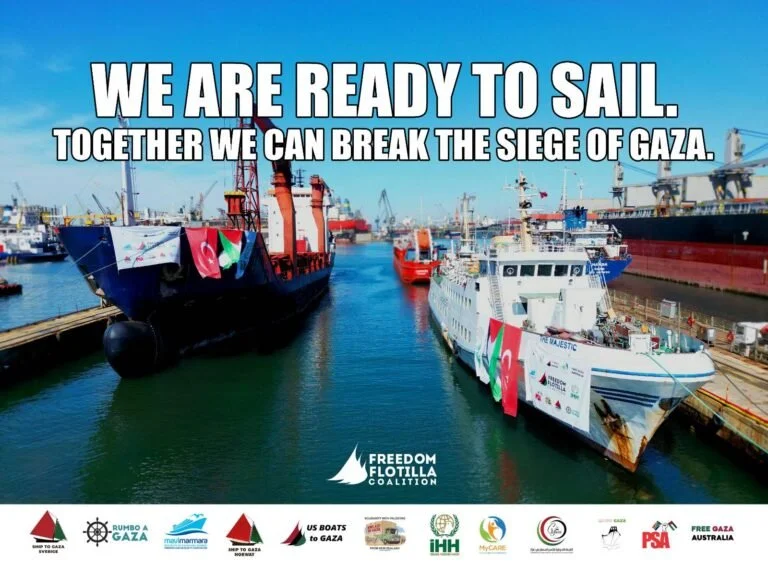Break the Siege Gaza – August 10 Threat Assessment Report
Executive Summary
The "Break the Siege Gaza" protest scheduled for August 10, 2025, is a national day of action organized by a coalition of activist groups demanding the end of the siege on Gaza, cessation of U.S. support for the Gaza Humanitarian Foundation (GHF), and the opening of the Rafah border crossing. Framed as a direct political intervention against U.S. and Israeli policy, this protest is anticipated to occur in multiple major U.S. cities. Due to the current high-intensity political environment, past incidents involving armed actors, and the likelihood of confrontations with law enforcement or counter-protesters, the overall threat to this event is High.
Threat Profiles
Law Enforcement Confrontation
The most immediate and probable threat to the August 10 protests is direct confrontation with law enforcement. Previous related protests—such as university encampments and antiwar marches—have resulted in mass arrests, aggressive crowd control tactics, and substantial media scrutiny. Protesters engaging in nonviolent civil disobedience or blocking infrastructure may be met with kettling, forced dispersals, or detainment. Given the explicit goals to challenge U.S. policy and government-funded operations in Gaza, federal agencies may surveil or infiltrate organizing networks.
Likelihood: High
Consequence: High (mass arrests, injuries, reputational damage, logistical disruption)
Counter-Protester Violence
There is a credible threat of physical or verbal confrontations instigated by nationalist, pro-Israel, or far-right counter-demonstrators. The Gaza solidarity movement has increasingly been framed in contentious terms, and actions bearing symbols of Hamas or Hezbollah—as seen in Tunisian protests—may provoke hostile reactions. As with previous “No Kings” protests, counter-protesters may arrive armed, potentially escalating interactions into violence.
Likelihood: Medium
Consequence: Moderate to High (assault, reputational damage, police crackdown)
Active Assailant (e.g., Knife or Firearm Attack)
The highly polarized nature of the Gaza issue and the presence of activists labeled as “terrorist sympathizers” by U.S. officials may inspire lone actors to attempt harm. Past incidents—including armed counter-protesters at Palestine-related and anti-Trump demonstrations—underscore this risk. A successful attack, even by a lone actor with a basic weapon, could result in fatalities, panic, and large-scale disruption.
Likelihood: Medium
Consequence: High (fatalities, mass panic, event collapse)
Unmanned Aircraft Systems (UAS) Intrusion
Drones may be used for surveillance by journalists, protest organizers, or hostile actors. There is a rising trend of UAS usage to provoke or gather intelligence during protests. Potential misuse includes disruptions, unauthorized broadcasting, or, in extreme scenarios, hazardous payload delivery. Urban density may limit immediate law enforcement response.
Likelihood: Medium
Consequence: Moderate (privacy violations, injury, tactical confusion)
Vehicle-Borne Improvised Explosive Device (VBIED)
Although no specific threat intelligence has indicated a VBIED plot, the visibility of this protest and its association with high-profile international conflict creates a symbolic target for extremist violence. Large, static gatherings in urban environments are vulnerable to vehicular attacks, whether intentional ramming or explosive-based.
Likelihood: Low
Consequence: Catastrophic (mass casualties, public panic, national media coverage)
Weather and Environmental Threats
August heat poses a mild but relevant health risk, especially to vulnerable protest participants such as the elderly or immunocompromised. There are no current extreme weather alerts, but sustained exposure without shade or hydration could cause heat exhaustion or dehydration. Storms or wind gusts could further endanger crowd stability and protest materials.
Likelihood: Medium
Consequence: Low (mild injury, logistical interference)
Recommendations
For Law Enforcement:
Law enforcement should prepare for large-scale, high-emotion gatherings with adequate staffing, de-escalation training, and mass detention logistics. Officers must clearly distinguish peaceful protesters from potential agitators and remain aware of the protest’s political sensitivity to avoid unnecessary escalation. Counter-UAS protocols should be prepared in coordination with federal agencies. Bomb detection and canine teams should be on standby in major cities hosting events.
For Security Planners:
Security planners should liaise with protest organizers to establish communication and nonviolence protocols. Medical support stations and water distribution should be arranged in anticipation of environmental health risks. Surveillance systems should monitor for drone incursions and suspicious vehicular activity. Efforts should be made to identify and isolate hostile counter-protesters before convergence. Coordination with municipal emergency management departments is essential to ensure rapid response capacity.


